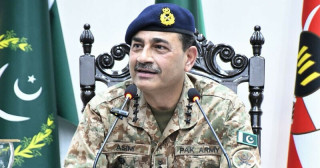Night_Hawk
Siasat.pk - Blogger
Cancer report card
EVERY five years, WHO publishes its world cancer report on the incidence of the disease and sets out broader policy directions.
Its latest edition, released recently, paints a world in which the incidence of cancer and cancer-related mortality is set to reach alarming proportions in the coming decade. The report predicts the load of new cases to rise from 12.7 million in 2012 to 25 million within the next 20 years, with deaths going up from 8.2 million to 13 million.
The most commonly diagnosed cancer among men is lung cancer which accounts for the largest mortality numbers. Breast cancer is the most common among women. WHO’s projection represents a 70pc increase in new cases. This whopping increase translates into an extra $1.16 trillion in health expenditure mostly to be borne by middle- and low-income countries where the burden of disease is predicted to be disproportionately high.
More than 60pc of new cancer cases and 70pc of fatalities are likely to be in Asia, Africa and Central and Southern America. Pakistan is one of the Asian countries which are set to experience an increasing financial burden. In the absence of reliable figures, the guesstimate of new cases hovered between 1.4 to 1.67 million during 2012.
This trend finds confirmation in various newspaper reports. One news report pointed out that in a local cancer specialist hospital in the capital there has been an alarming upward trend in the number of cancer cases.
More alarming, of every 10 patients attending the hospital three were diagnosed with breast cancer. Yet another WHO study highlighted the growing incidence of cervical cancer among women. As compared to nine deaths per 100,000 in 2008 the number has increased to 13.9 in recent years.
Similarly, the incidence of lung cancer is also thought to be very high, bound up as it is with the higher prevalence of smoking in Pakistan. These headline figures are also corroborated by increasing anecdotal evidence from friends and family who have experienced a brush with the killer disease.
This helps us put faces to these figures and the associated high cost which the disease is exacting on people and the healthcare system.
While in the West the incidence of cancer is connected to lifestyle and aging, in Pakistan cancer is laying its deathly hands on relatively younger victims. The number of such people known to me or known through friends is rising steeply.
This list includes one of the editors of this media group whose early death due to lung cancer has left many of his friends in deep shock. I can also name other friends who have been scythed by cancer in their prime. Each family has a different story to tell in so far as the ordeal of diagnosis and the spiral of suffering is concerned. What emerges from these stories is that often the shock of being diagnosed with cancer is further compounded by either misdiagnosis or late diagnosis.
Poor detection and diagnosis is one part of the story. Another is the cost of treatment where poor patients are concerned. Only a tiny minority is able to go abroad for treatment. A large majority of cancer sufferers are disadvantaged by the cost of the treatment even if they obtain an accurate diagnosis early enough.
What is galling for these patients is that there is no discernible governmental strategy in place, or in the offing, that addresses the high cost of cancer treatment. In other countries such as India, robust governmental action has ensured that the poor are also treated via generic drug production of expensive and expired patents.
However, despite the government’s absence of an anti-cancer strategy there has been a profusion of cancer hospitals in the country. Shaukat Khanum is the trailblazer. Likewise there have been awareness campaigns around the issue of breast cancer.
There are also other specialist hospitals coming up which are rooted in the ethos of making quality healthcare care accessible to patients regardless of their ability to pay. The Sindh Institute of Urology and Transplantation has led the way.
Yet the problem is too huge, with the caseload increasing by more than a million each year. What is required is a comprehensive cancer prevention and treatment policy which places issues of early prevention, diagnosis and affordable treatment at its core.
Equally important is focused public action to demand better service provision in cancer prevention, detection and treatment alongside well-funded cancer research.
The World Cancer Report 2014 is a timely reminder of the deadly disease that is already upon us and which we can only ignore at our peril — both at the personal and healthcare system level.
The writer is an Islamabad-based development consultant and policy analyst.
http://www.dawn.com/news/1086154/cancer-report-card
EVERY five years, WHO publishes its world cancer report on the incidence of the disease and sets out broader policy directions.
Its latest edition, released recently, paints a world in which the incidence of cancer and cancer-related mortality is set to reach alarming proportions in the coming decade. The report predicts the load of new cases to rise from 12.7 million in 2012 to 25 million within the next 20 years, with deaths going up from 8.2 million to 13 million.
The most commonly diagnosed cancer among men is lung cancer which accounts for the largest mortality numbers. Breast cancer is the most common among women. WHO’s projection represents a 70pc increase in new cases. This whopping increase translates into an extra $1.16 trillion in health expenditure mostly to be borne by middle- and low-income countries where the burden of disease is predicted to be disproportionately high.
More than 60pc of new cancer cases and 70pc of fatalities are likely to be in Asia, Africa and Central and Southern America. Pakistan is one of the Asian countries which are set to experience an increasing financial burden. In the absence of reliable figures, the guesstimate of new cases hovered between 1.4 to 1.67 million during 2012.
This trend finds confirmation in various newspaper reports. One news report pointed out that in a local cancer specialist hospital in the capital there has been an alarming upward trend in the number of cancer cases.
More alarming, of every 10 patients attending the hospital three were diagnosed with breast cancer. Yet another WHO study highlighted the growing incidence of cervical cancer among women. As compared to nine deaths per 100,000 in 2008 the number has increased to 13.9 in recent years.
Similarly, the incidence of lung cancer is also thought to be very high, bound up as it is with the higher prevalence of smoking in Pakistan. These headline figures are also corroborated by increasing anecdotal evidence from friends and family who have experienced a brush with the killer disease.
This helps us put faces to these figures and the associated high cost which the disease is exacting on people and the healthcare system.
While in the West the incidence of cancer is connected to lifestyle and aging, in Pakistan cancer is laying its deathly hands on relatively younger victims. The number of such people known to me or known through friends is rising steeply.
This list includes one of the editors of this media group whose early death due to lung cancer has left many of his friends in deep shock. I can also name other friends who have been scythed by cancer in their prime. Each family has a different story to tell in so far as the ordeal of diagnosis and the spiral of suffering is concerned. What emerges from these stories is that often the shock of being diagnosed with cancer is further compounded by either misdiagnosis or late diagnosis.
Poor detection and diagnosis is one part of the story. Another is the cost of treatment where poor patients are concerned. Only a tiny minority is able to go abroad for treatment. A large majority of cancer sufferers are disadvantaged by the cost of the treatment even if they obtain an accurate diagnosis early enough.
What is galling for these patients is that there is no discernible governmental strategy in place, or in the offing, that addresses the high cost of cancer treatment. In other countries such as India, robust governmental action has ensured that the poor are also treated via generic drug production of expensive and expired patents.
However, despite the government’s absence of an anti-cancer strategy there has been a profusion of cancer hospitals in the country. Shaukat Khanum is the trailblazer. Likewise there have been awareness campaigns around the issue of breast cancer.
There are also other specialist hospitals coming up which are rooted in the ethos of making quality healthcare care accessible to patients regardless of their ability to pay. The Sindh Institute of Urology and Transplantation has led the way.
Yet the problem is too huge, with the caseload increasing by more than a million each year. What is required is a comprehensive cancer prevention and treatment policy which places issues of early prevention, diagnosis and affordable treatment at its core.
Equally important is focused public action to demand better service provision in cancer prevention, detection and treatment alongside well-funded cancer research.
The World Cancer Report 2014 is a timely reminder of the deadly disease that is already upon us and which we can only ignore at our peril — both at the personal and healthcare system level.
The writer is an Islamabad-based development consultant and policy analyst.
http://www.dawn.com/news/1086154/cancer-report-card
Last edited by a moderator:


























